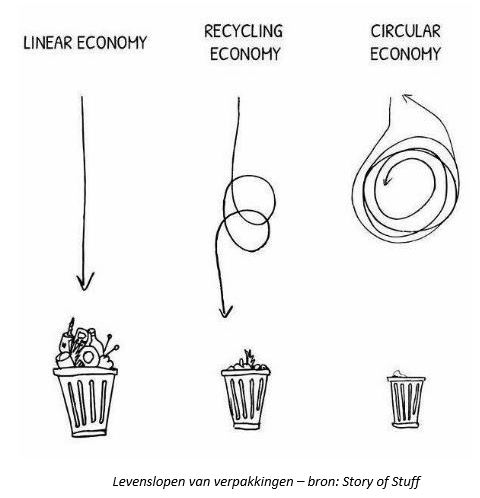- Library
- KIDV model ‘Five perspectives on sustainable packaging’ ®
- Packaging in a circular economy
Packaging in a circular economy
A circular economy is an economic system in which the reusability of products and raw materials is maximised and wastefulness is minimised. A circular system is characterised by two cycles for materials:
- a biological cycle, in which residual materials are safely returned to the natural environment after use, and
- a technical cycle, for which products and components are designed and marketed in such a way that they can be reused in a high-quality manner.
The image shows the differences between the lifecycles of packaging materials in a linear economy, a recycling economy, and a circular economy. At the moment, most businesses in the Netherlands are transitioning from a linear economy to a recycling economy in terms of their packaging processes and materials, while some organisations are already moving towards the implementation of a circular economy.
Linear economy
In a linear economy, businesses use raw materials for the production of packaging materials, which are then disposed of as residual waste after use. As a sustainability measure, they try to reduce the amount of raw materials used as much as possible, so they generate less waste. In a linear economy, all used packaging materials are disposed of as waste. In the Netherlands, this means that the packaging waste is burned with energy recovery. In other countries, this may mean that no energy recovery occurs or that the waste is disposed of in landfills.
Recycling economy
In a recycling economy, businesses try to reuse packaging materials and materials are recycled as much as possible. In addition to reducing the amount of raw materials used, businesses often strive towards one or more of the following three options:
- Reuse: businesses develop packaging materials that can be reused. Sometimes, they may use specific return systems designed to collect the packaging materials, clean them if necessary, and then reuse them as packaging materials for new products.
- Recycling: businesses take existing waste collection systems and the option to separate different materials into account when choosing their packaging materials. The separated materials can be recycled into new raw materials with similar or different properties as before.
- Renewal: in some cases, businesses make use of materials that are made from renewable raw materials. These materials can be recycled or composted after use.
In a recycling economy, it is often difficult to keep the quality of recycled materials optimal and allow them to be recycled over and over again. For example because packaging materials cannot be separated effectively enough, which still creates a significant amount of residual waste. As a result, the production of new packaging materials still requires the use of a large percentage of new raw materials to complement the recycled materials.
Circular economy
Packaging in a circular economy means that all wastefulness is eliminated from the packaging chain and that no raw materials are lost. That means:
- minimising the use of raw materials by using fewer materials for the development of packaging materials, but also wasting less product;
- ensuring that the raw materials used for packaging materials come from renewable sources whenever possible. It is important that these sources are properly managed, so important nutrients are preserved for the environment;
- designing product-packaging combinations, materials, and processes in such a way that raw materials continue to cycle. This is realised by reusing packaging materials whenever possible and recycling materials in a lasting manner;
- designing product-packaging combinations in such a way that all negative aspects are eliminated. This mainly concerns negative effects on our food supply, health, water supply, land usage, and air pollution.
In order to move from a recycling economy towards a circular economy, it is essential for all parties in the packaging chain to cooperate optimally.
More information
Transition to a circular economy
Why is the transition to a circular economy so important? How can you contribute to this transition with your packaging development process?
A closer look: the plastic packaging chain
What needs to be done to further close the plastic packaging chain? How can you contribute to that with your packaging development process?
Collection and recycling
How are packaging materials recycled? How can you make sure during the design process that your packaging can properly be recycled later on?
Measuring sustainability
Which packaging materials are most sustainable? How can you quantify the sustainability of a product-packaging combination?